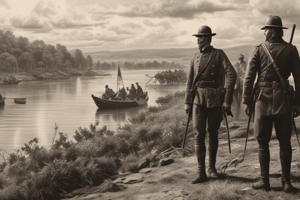Podcast
Questions and Answers
What was the primary aim of President Abraham Lincoln's Ten Percent Plan?
What was the primary aim of President Abraham Lincoln's Ten Percent Plan?
- To provide economic justice for formerly enslaved individuals
- To ensure voting rights for freed slaves
- To focus on addressing the needs of Confederate leaders
- To restore the Union with states reaching 10% voter turnout (correct)
What did the 13th Amendment, ratified in December 1865, aim to achieve?
What did the 13th Amendment, ratified in December 1865, aim to achieve?
- Implement Black Codes in the Southern states
- Provide land distribution for former Confederate leaders
- Ensure voting rights for freed slaves
- Abolish slavery throughout the country (correct)
Who played a central role in advocating for broader rights for freed slaves during the Reconstruction era?
Who played a central role in advocating for broader rights for freed slaves during the Reconstruction era?
- Radical Republicans (correct)
- Southern plantation owners
- Union generals
- Former Confederate leaders
What was a major issue left unaddressed by the 13th Amendment in terms of freed slaves' rights?
What was a major issue left unaddressed by the 13th Amendment in terms of freed slaves' rights?
What were Black Codes implemented by Southern states following the Civil War aimed at achieving?
What were Black Codes implemented by Southern states following the Civil War aimed at achieving?
What did the Reconstruction Acts of 1867 mandate in the Confederate states?
What did the Reconstruction Acts of 1867 mandate in the Confederate states?
Which legislative action led to the abolition of Black Codes in the United States?
Which legislative action led to the abolition of Black Codes in the United States?
Who advocated for the full integration of African American citizens into American society post-Civil War?
Who advocated for the full integration of African American citizens into American society post-Civil War?
What was the primary aim of the Black Codes adopted initially in Louisiana in 1865?
What was the primary aim of the Black Codes adopted initially in Louisiana in 1865?
Which president's attempts to remove state governors elected without white support led to tensions during Reconstruction?
Which president's attempts to remove state governors elected without white support led to tensions during Reconstruction?
Flashcards are hidden until you start studying
Study Notes
Post-Conflict Restoration: A Decade of Reconstructing America After the Civil War
Following four years of devastating conflict, the United States faced the immense challenge of restoring its fragmented communities while upholding the newly achieved emancipation of African Americans. This transformational period saw various initiatives aimed at reconstruction – the process through which the North sought to reunite the nation, ensure civil rights for freed slaves, and establish political stability.
The Civil War's aftermath revealed widespread destruction in areas like Virginia, Tennessee, Mississippi, South Carolina, and Georgia, leading many liberated enslaved people to migrate from the Deep South seeking better opportunities elsewhere. To address these challenges, President Abraham Lincoln proposed his Ten Percent Plan, aiming to restore the Union with states reaching 10% voter turnout, primarily former unionists. However, this plan did little to ensure equality for formerly enslaved individuals; subsequent policies would focus more heavily on addressing their needs.
One such policy was the 13th Amendment. Passed by Congress on January 31st, 1865, and ratified in December, it abolished slavery throughout the country. Yet, though ending bondage legally, it left unaddressed broader questions regarding voting rights, land distribution, and economic justice for those who had been enslaved. These issues became central concerns during the era of reconstruction.
To enforce and accelerate reform efforts, Congress passed the Reconstruction Acts in March 1867. These acts divided the Confederacy into five military districts administered directly by federal officials. They also mandated revised state constitutions including provisions guaranteeing suffrage for black men and requiring oaths of loyalty to the Union for all male citizens over age 21..
However, despite such progress, there emerged attempts to obstruct full integration via oppressive measures known as Black Codes. Initially adopted in Louisiana in late 1865, these codes imposed restrictions on blacks' behavior and movement, effectively reinstating some aspects of slavery under different names. Such laws were outlawed after passage of the Fourteenth Amendment in July 1868.
During this time, radical Republican leaders, often referred to collectively as "Radicals," held significant influence within both chambers. This faction strove towards integrating African American citizens fully into American society, advocating for equal protection before the law and voting rights. However, tensions between Radicals and conservative factions led to conflicts such as in South Carolina, where President Andrew Johnson attempted to remove state governors elected without white support, precipitating the infamous "Battle of the Oval Office." This event highlighted underlying divisions on how fast to integrate African Americans into Southern politics following the war.
In summary, reconstruction in postbellum America involved numerous complex endeavors to secure peace and equity among diverse societal groups. Efforts ranged from constitutional amendments prohibiting slavery and guaranteeing equal protection, to direct government interventionist actions designed to facilitate social change. Despite moments of progress, heightened tension often accompanied each step forward, demonstrating how far the U.S. still needed to travel before achieving true reconciliation among its citizenry.
Studying That Suits You
Use AI to generate personalized quizzes and flashcards to suit your learning preferences.




